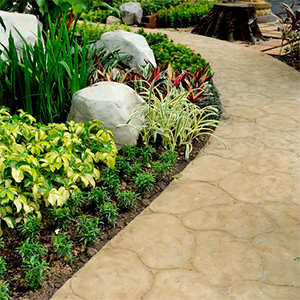Leading Landscaping Companies Jacksonville: Specialist Landscaping for Every Need
Elevate Your Home's Aesthetic With Sustainable Landscape Design Designs and Eco-Friendly Practices

Benefits of Sustainable Landscaping
Carrying out lasting landscaping techniques not only conserves all-natural resources but additionally promotes biodiversity and enhances total environmental health. One significant benefit is the decrease of water consumption via the use of drought-resistant plants, rainfall gardens, and reliable irrigation systems.
Moreover, sustainable landscape design can enhance dirt health by lessening the usage of chemical fertilizers and chemicals, thereby developing a healthier setting for plant development and advantageous dirt organisms. This, subsequently, improves the total durability of the landscape to endure ecological stress factors and environment modification influences - landscaping companies Jacksonville. Additionally, lasting landscape design methods can attract varied wild animals, including pollinators like and butterflies, promoting an extra well balanced and vibrant community within the home
Incorporating Native Plants
To build on the advantages of lasting landscaping, a tactical concentrate on integrating native plants can additionally improve environmental resilience and promote biodiversity within the landscape. Native plants are species that naturally occur in a particular location and have progressed to prosper in the regional climate, soil conditions, and environment. By consisting of native plants in landscape design layouts, homeowner can decrease water usage, reduce the need for chemical pesticides and fertilizers, and support the neighborhood wildlife population.
Integrating indigenous plants likewise assists in protecting the distinct character and identification of a region's flora. These plants frequently require much less maintenance once developed, making them a cost-effective and sustainable landscaping solution in the lengthy run. Furthermore, native plants can draw in native pollinators like bees and butterflies, contributing to the overall wellness of the ecological community.
When choosing indigenous plants for landscape design projects, it is important to pick types that are well-suited to the details ecological problems of the site. Consulting with neighborhood nurseries or arboretums can provide beneficial support on selecting the ideal native plants for a particular location. By integrating indigenous plants into landscaping designs, property proprietors can create lovely, sustainable outside rooms that benefit both the area and the environment.

Water Preservation Techniques
Reliable watering techniques play an essential role in lasting landscape design methods, making sure ideal water conservation efforts in exterior areas. Applying strategies such as drip irrigation, rainwater harvesting, and clever watering systems can substantially minimize water wastage while preserving a healthy landscape. Drip watering delivers water straight to the origins of plants, lessening evaporation and runoff. Rain harvesting entails collecting rain from roofings and storing it for later usage in watering, minimizing the reliance on community water sources. Smart watering systems utilize weather condition data and dirt wetness degrees to change sprinkling routines, avoiding overwatering and advertising water effectiveness.
In enhancement to sophisticated irrigation techniques, xeriscaping is one more water-saving landscape design technique that concentrates on using drought-resistant plants, mulch, and reliable irrigation to produce a low-water landscape layout - landscaping companies Jacksonville. By picking native plants that are appropriate to the neighborhood environment and dirt conditions, homeowner can decrease the requirement for too much watering, ultimately conserving water and promoting a sustainable outside environment
Eco-Friendly Hardscaping Concepts
Enhancing outside areas with green hardscaping attributes can contribute dramatically to sustainable landscaping methods. Decide for products like redeemed timber, recycled concrete, or all-natural stone to reduce environmental effect when thinking about hardscaping aspects. These products not just add an unique aesthetic interest your outside area however likewise decrease the requirement for new resources extraction.
Executing permeable paving alternatives such as crushed rock or absorptive concrete can help in reducing water runoff and advertise groundwater recharge. These options enable rainwater to seep into the ground, preventing erosion and lessening the worry on stormwater systems.
Integrating indigenous plants right into hardscaping styles can further enhance eco-friendliness by supporting local wildlife and reducing the need for extreme watering or chemical treatments. By including environment-friendly wall surfaces or vertical yards, you can introduce more vegetation right into urban setups, improving air high quality look these up and biodiversity.
Incorporating energy-efficient lights, such as solar-powered LEDs, into hardscaping styles can reduce electrical power intake and lower your property's carbon footprint. Focusing on green hardscaping concepts not only improves the charm of your exterior area but additionally demonstrates a dedication to ecological stewardship.
Maintenance Tips for Sustainable Landscapes
:max_bytes(150000):strip_icc()/2583801_toddd_49-1-bc209c65ca1a4917afe2f2cbc437027c.jpg)
Regularly prune plants to promote healthy and balanced growth and prevent overgrowth that can lead to pest diseases or problems. Usage organic plant foods to nourish the soil and lawn cleanup Jacksonville plants without unsafe chemicals that can seep into the environment.
Final Thought
In conclusion, sustainable landscaping practices offer countless advantages for homeowner, from enhancing the aesthetic appeal of the surroundings to advertising ecological conservation. By integrating native plants, applying water conservation methods, and using environment-friendly hardscaping concepts, residential or commercial property proprietors can create gorgeous landscapes that are also ecologically liable. With correct upkeep, sustainable landscapes can contribute and thrive to a healthier ecosystem for both people and wildlife.
Additionally, sustainable landscape design can enhance soil health by minimizing the use of chemical fertilizers and chemicals, thereby producing a healthier atmosphere for plant development and valuable soil organisms.To build upon the advantages of sustainable landscape design, a tactical emphasis on integrating indigenous plants can better enhance environmental durability and promote biodiversity within the landscape. By including native plants in landscaping designs, building proprietors can lower water use, minimize the requirement for chemical pesticides and plant foods, and support the regional wildlife populace.
These plants typically need less upkeep as soon as developed, making them a economical and lasting landscape design solution in the lengthy run. By integrating indigenous plants right into landscape design layouts, property proprietors can develop attractive, lasting outside areas that click this site profit both the community and the atmosphere.